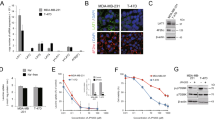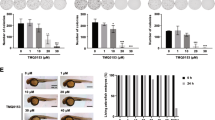Abstract
This study was carried out to understand the effect of the recombinant multivalent extracellular matrix metalloproteinase inducer (EMMPRIN) extracellular domain, designated as rmEMMPRINex, on the apoptotic cell death of human leukemia U937 cells. Expression of monocarboxylate transporter 1 (MCT1) and caspase-9 in U937 treated with rmEMMPRINex was investigated in this study. Levels of membrane MCT1 and intracellular procaspase-9 were decreased in rmEMMPRINex-treated cells in comparison to controls. However, the expression of activated caspase-9 was undetectable. rmEMMPRINex also induced DNA fragmentation and apoptosis in U937 cells. Taken together, we concluded that interaction of rmEMMPRINex with U937 cells leads to inhibition of MCT1 membrane expression, intracellular activation of procaspase-9, followed by DNA fragmentation and apoptosis. This may contribute to the conceptual development of novel cancer drugs in the future.





Similar content being viewed by others
References
Biswas, C., Zhang, Y., DeCastro, R., Guo, H., Nakamura, T., Kataoka, H., et al. (1995). The human tumor cell-derived collagenase stimulatory factor (renamed EMMPRIN) is a member of the immunoglobulin superfamily. Cancer Research, 55, 434–439.
Kirsch, A. H., Diaz, L. A., Jr., Bonish, B., Antony, P. A., & Fox, D. A. (1997). The pattern of expression of CD147/neurothelin during human T-cell ontogeny as defined by the monoclonal antibody 8D6. Tissue Antigens, 50, 147–152.
Schmidt, R., Staats, P., Groneberg, D. A., & Wagner, U. (2008). Effect of montelukast on platelet activating factor- and tachykinin induced mucus secretion in the rat. Journal of Occupational Medicine Toxicology, 3, 5.
Chen, Y., Zhang, H., Gou, X., Horikawa, Y., Xing, J., & Chen, Z. (2009). Upregulation of HAb18G/CD147 in activated human umbilical vein endothelial cells enhances the angiogenesis. Cancer Letters, 278, 113–121.
Chen, H., Wang, L., Beretov, J., Hao, J., Xiao, W., & Li, Y. (2010). Co-expression of CD147/EMMPRIN with monocarboxylate transporters and multiple drug resistance proteins is associated with epithelial ovarian cancer progression. Clinical and Experimental Metastasis, 27, 557–569.
Dai, J. Y., Dou, K. F., Wang, C. H., Zhao, P., Lau, W. B., Tao, L., et al. (2009). The interaction of HAb18G/CD147 with integrin alpha6beta1 and its implications for the invasion potential of human hepatoma cells. BMC Cancer, 9, 337.
Tang, Y., Nakada, M. T., Kesavan, P., McCabe, F., Millar, H., Rafferty, P., et al. (2005). Extracellular matrix metalloproteinase inducer stimulates tumor angiogenesis by elevating vascular endothelial cell growth factor and matrix metalloproteinases. Cancer Research, 65, 3193–3199.
Staffler, G., & Stockinger, H. (2000). Cd147. Journal of Biological Regulators and Homeostatic Agents, 14, 327–330.
Kasinrerk, W., Fiebiger, E., Stefanova, I., Baumruker, T., Knapp, W., & Stockinger, H. (1992). Human leukocyte activation antigen M6, a member of the Ig superfamily, is the species homologue of rat OX-47, mouse basigin, and chicken HT7 molecule. Journal of Immunology, 149, 847–854.
Miyauchi, T., Masuzawa, Y., & Muramatsu, T. (1991). The basigin group of the immunoglobulin superfamily: complete conservation of a segment in and around transmembrane domains of human and mouse basigin and chicken HT7 antigen. Journal of Biochemistry (Tokyo), 110, 770–774.
Fossum, S., Mallett, S., & Barclay, A. N. (1991). The MRC OX-47 antigen is a member of the immunoglobulin superfamily with an unusual transmembrane sequence. European Journal of Immunology, 21, 671–679.
Yoshida, S., Shibata, M., Yamamoto, S., Hagihara, M., Asai, N., Takahashi, M., et al. (2000). Homo-oligomer formation by basigin, an immunoglobulin superfamily member, via its N-terminal immunoglobulin domain. European Journal of Biochemistry, 267, 4372–4380.
Sun, J., & Hemler, M. E. (2001). Regulation of MMP-1 and MMP-2 production through CD147/extracellular matrix metalloproteinase inducer interactions. Cancer Research, 61, 2276–2281.
Tang, W., Chang, S. B., & Hemler, M. E. (2004). Links between CD147 function, glycosylation, and caveolin-1. Molecular Biology of the Cell, 15, 4043–4050.
Li, Y., Wu, J., Song, F., Tang, J., Wang, S. J., Yu, X. L., Chen, Z. N., & Jiang, J. L. (2012). Extracellular membrane-proximal domain of HAb18G/CD147 binds to metal ion-dependent adhesion site (MIDAS) motif of integrin beta1 to modulate malignant properties of hepatoma cells. Journal of Biological Chemistry, 287, 4759–4772.
Tayapiwatana, C., Arooncharus, P., & Kasinrerk, W. (2003). Displaying and epitope mapping of CD147 on VCSM13 phages: influence of Escherichia coli strains. Journal of Immunological Methods, 281, 177–185.
Intasai, N., Arooncharus, P., Kasinrerk, W., & Tayapiwatana, C. (2003). Construction of high-density display of CD147 ectodomain on VCSM13 phage via gpVIII: effects of temperature, IPTG, and helper phage infection-period. Protein Expression and Purification, 32, 323–331.
Intasai, N., Mai, S., Kasinrerk, W., & Tayapiwatana, C. (2006). Binding of multivalent CD147 phage induces apoptosis of U937 cells. International Immunology, 18, 1159–1169.
Kasinrerk, W., Tokrasinwit, N., & Phunpae, P. (1999). CD147 monoclonal antibodies induce homotypic cell aggregation of monocytic cell line U937 via LFA-1/ICAM-1 pathway. Immunology, 96, 184–192.
Khunkeawla, P., Moonsom, S., Staffler, G., Kongtawelert, P., & Kasinrerk, W. (2001). Engagement of CD147 molecule-induced cell aggregation through the activation of protein kinases and reorganization of the cytoskeleton. Immunobiology, 203, 659–669.
Halestrap, A. P., & Price, N. T. (1999). The proton-linked monocarboxylate transporter (MCT) family: structure, function and regulation. Biochemistry Journal, 343, 281–299.
Halestrap, A. P., & Meredith, D. (2004). The SLC16 gene family-from monocarboxylate transporters (MCTs) to aromatic amino acid transporters and beyond. Pflügers Archiv, 447, 619–628.
Wahl, M. L., Owen, J. A., Burd, R., Herlands, R. A., Nogami, S. S., Rodeck, U., et al. (2002). Regulation of intracellular pH in human melanoma: potential therapeutic implications. Molecular Cancer Therapeutics, 1, 617–628.
Mathupala, S. P., Parajuli, P., & Sloan, A. E. (2004). Silencing of monocarboxylate transporters via small interfering ribonucleic acid inhibits glycolysis and induces cell death in malignant glioma: an in vitro study. Neurosurgery, 55, 1410–1419. discussion 1419.
Fang, F., Flegler, A. J., Du, P., Lin, S., & Clevenger, C. V. (2008). Expression of cyclophilin B is associated with malignant progression and regulation of genes implicated in the pathogenesis of breast cancer. American Journal of Pathology, 174, 297–308.
Sonveaux, P., Vegran, F., Schroeder, T., Wergin, M. C., Verrax, J., Rabbani, Z. N., et al. (2008). Targeting lactate-fueled respiration selectively kills hypoxic tumor cells in mice. Journal of Clinical Investigation, 118, 3930–3942.
Cho, K. S., Yamada, T., Wynn, C., Behanna, H. A., Hong, I. C., Manaves, V., et al. (2010). Mechanism analysis of long-term graft survival by monocarboxylate transporter-1 inhibition. Transplantation, 90, 1299–1306.
Kumar, A., Kant, S., & Singh, S. M. (2012). Novel molecular mechanisms of antitumor action of dichloroacetate against T cell lymphoma: implication of altered glucose metabolism, pH homeostasis and cell survival regulation. Chemico-Biological Interactions, 199, 29–37.
Czerski, L., & Nunez, G. (2004). Apoptosome formation and caspase activation: is it different in the heart? Journal of Molecular and Cellular Cardiology, 37, 643–652.
Cho, S. G., & Choi, E. J. (2002). Apoptotic signaling pathways: caspases and stress-activated protein kinases. Journal of Biochemistry and Molecular Biology, 35, 24–27.
Herold, M. J., Kuss, A. W., Kraus, C., & Berberich, I. (2002). Mitochondria-dependent caspase-9 activation is necessary for antigen receptor-mediated effector caspase activation and apoptosis in WEHI 231 lymphoma cells. Journal of Immunology, 168, 3902–3909.
Berard, M., Mondiere, P., Casamayor-Palleja, M., Hennino, A., Bella, C., & Defrance, T. (1999). Mitochondria connects the antigen receptor to effector caspases during B cell receptor-induced apoptosis in normal human B cells. Journal of Immunology, 163, 4655–4662.
Bouchon, A., Krammer, P. H., & Walczak, H. (2000). Critical role for mitochondria in B cell receptor-mediated apoptosis. European Journal of Immunology, 30, 69–77.
Ashkenazi, A., & Dixit, V. M. (1998). Death receptors: signaling and modulation. Science, 281, 1305–1308.
Wallach, D., Varfolomeev, E. E., Malinin, N. L., Goltsev, Y. V., Kovalenko, A. V., & Boldin, M. P. (1999). Tumor necrosis factor receptor and Fas signaling mechanisms. Annual Review of Immunology, 17, 331–367.
Guo, H., Zucker, S., Gordon, M. K., Toole, B. P., & Biswas, C. (1997). Stimulation of matrix metalloproteinase production by recombinant extracellular matrix metalloproteinase inducer from transfected Chinese hamster ovary cells. Journal of Biological Chemistry, 272, 24–27.
Papadimitropoulou, A., & Mamalaki, A. (2013). The glycosylated IgII extracellular domain of EMMPRIN is implicated in the induction of MMP-2. Molecular and Cellular Biochemistry, 379, 107–113.
Kawakami, T., Sameshima, T., Hojo, H., Koga, K., Nakahara, Y., Toole, B. P., et al. (2011). Synthetic emmprin peptides with chitobiose substitution stimulate MMP-2 production by fibroblasts. BMC Cancer, 11, 300.
Belton, R. J., Jr., Chen, L., Mesquita, F. S., & Nowak, R. A. (2008). Basigin-2 is a cell surface receptor for soluble basigin ligand. Journal of Biological Chemistry, 283, 17805–17814.
Widlak, P., & Garrard, W. T. (2009). Roles of the major apoptotic nuclease-DNA fragmentation factor-in biology and disease. Cellular and Molecular Life Sciences, 66, 263–274.
Kawane, K., & Nagata, S. (2008). Nucleases in programmed cell death. Methods in Enzymology, 442, 271–287.
Martin, S. J., & Green, D. R. (1995). Protease activation during apoptosis: death by a thousand cuts? Cell, 82, 349–352.
Soldani, C., Lazze, M. C., Bottone, M. G., Tognon, G., Biggiogera, M., Pellicciari, C. E., et al. (2001). Poly(ADP-ribose) polymerase cleavage during apoptosis: when and where? Experimental Cell Research, 269, 193–201.
Cohen, G. M., Sun, X. M., Snowden, R. T., Dinsdale, D., & Skilleter, D. N. (1992). Key morphological features of apoptosis may occur in the absence of internucleosomal DNA fragmentation. Biochemistry Journal, 286, 331–334.
Bortner, C. D., Oldenburg, N. B., & Cidlowski, J. A. (1995). The role of DNA fragmentation in apoptosis. Trends in Cell Biology, 5, 21–26.
Sun, X. M., & Cohen, G. M. (1994). Mg(2+)-dependent cleavage of DNA into kilobase pair fragments is responsible for the initial degradation of DNA in apoptosis. Journal of Biological Chemistry, 269, 14857–14860.
Acknowledgments
This work was supported by the Thailand Research Fund, the Commission on Higher Education, Chiang Mai University and the NSTDA Research Chair Grant, National Sciences and Technology Development Agency (Thailand). The author is eternally grateful to Mr. Wutigri Nimlamool, Ms. Watinee Yatfoong, Mr. Somphot Saoin, Mr. Prakitnavin Pingmuang, Mr. Chatree Plianpairoj, Ms. Patcharee Nochod, Ms. Kamonrat Puttimool, Mr. Warachai Praditwongwarn, Ms. Tipattaraporn Panich, and Mr. Anucha Pikool for their technical assistances. We also acknowledge Mr. Landon Wark for English proofing.
Conflict of interest
We declare that we have no conflict of interest.
Author information
Authors and Affiliations
Corresponding author
Rights and permissions
About this article
Cite this article
Intasai, N., Pata, S., Tragoolpua, K. et al. Recombinant Multivalent EMMPRIN Extracellular Domain Induces U937 Human Leukemia Cell Apoptosis by Downregulation of Monocarboxylate Transporter 1 and Activation of Procaspase-9. Appl Biochem Biotechnol 176, 1781–1790 (2015). https://doi.org/10.1007/s12010-015-1677-0
Received:
Accepted:
Published:
Issue Date:
DOI: https://doi.org/10.1007/s12010-015-1677-0




